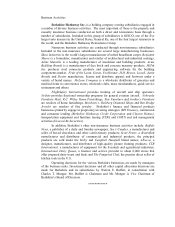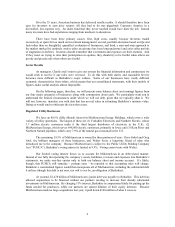Berkshire Hathaway 2004 Annual Report Download - page 7
Download and view the complete annual report
Please find page 7 of the 2004 Berkshire Hathaway annual report below. You can navigate through the pages in the report by either clicking on the pages listed below, or by using the keyword search tool below to find specific information within the annual report.Insurance
Since Berkshire purchased National Indemnity (“NICO”) in 1967, property-casualty insurance has
been our core business and the propellant of our growth. Insurance has provided a fountain of funds with
which we’ ve acquired the securities and businesses that now give us an ever-widening variety of earnings
streams. So in this section, I will be spending a little time telling you how we got where we are.
The source of our insurance funds is “float,” which is money that doesn’ t belong to us but that we
temporarily hold. Most of our float arises because (1) premiums are paid upfront though the service we
provide – insurance protection – is delivered over a period that usually covers a year and; (2) loss events
that occur today do not always result in our immediately paying claims, because it sometimes takes many
years for losses to be reported (asbestos losses would be an example), negotiated and settled. The $20
million of float that came with our 1967 purchase has now increased – both by way of internal growth and
acquisitions – to $46.1 billion.
Float is wonderful – if it doesn’ t come at a high price. Its cost is determined by underwriting
results, meaning how the expenses and losses we will ultimately pay compare with the premiums we have
received. When an underwriting profit is achieved – as has been the case at Berkshire in about half of the
38 years we have been in the insurance business – float is better than free. In such years, we are actually
paid for holding other people’ s money. For most insurers, however, life has been far more difficult: In
aggregate, the property-casualty industry almost invariably operates at an underwriting loss. When that
loss is large, float becomes expensive, sometimes devastatingly so.
Insurers have generally earned poor returns for a simple reason: They sell a commodity-like
product. Policy forms are standard, and the product is available from many suppliers, some of whom are
mutual companies (“owned” by policyholders rather than stockholders) with profit goals that are limited.
Moreover, most insureds don’ t care from whom they buy. Customers by the millions say “I need some
Gillette blades” or “I’ ll have a Coke” but we wait in vain for “I’ d like a National Indemnity policy, please.”
Consequently, price competition in insurance is usually fierce. Think airline seats.
So, you may ask, how do Berkshire’ s insurance operations overcome the dismal economics of the
industry and achieve some measure of enduring competitive advantage? We’ ve attacked that problem in
several ways. Let’ s look first at NICO’ s strategy.
When we purchased the company – a specialist in commercial auto and general liability insurance
– it did not appear to have any attributes that would overcome the industry’ s chronic troubles. It was not
well-known, had no informational advantage (the company has never had an actuary), was not a low-cost
operator, and sold through general agents, a method many people thought outdated. Nevertheless, for
almost all of the past 38 years, NICO has been a star performer. Indeed, had we not made this acquisition,
Berkshire would be lucky to be worth half of what it is today.
What we’ ve had going for us is a managerial mindset that most insurers find impossible to
replicate. Take a look at the facing page. Can you imagine any public company embracing a business
model that would lead to the decline in revenue that we experienced from 1986 through 1999? That
colossal slide, it should be emphasized, did not occur because business was unobtainable. Many billions of
premium dollars were readily available to NICO had we only been willing to cut prices. But we instead
consistently priced to make a profit, not to match our most optimistic competitor. We never left customers
– but they left us.
Most American businesses harbor an “institutional imperative” that rejects extended decreases in
volume. What CEO wants to report to his shareholders that not only did business contract last year but that
it will continue to drop? In insurance, the urge to keep writing business is also intensified because the
consequences of foolishly-priced policies may not become apparent for some time. If an insurer is
optimistic in its reserving, reported earnings will be overstated, and years may pass before true loss costs
are revealed (a form of self-deception that nearly destroyed GEICO in the early 1970s).
6




















